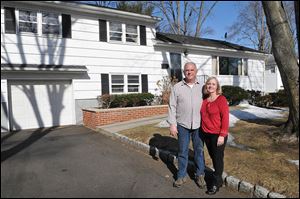
Split decision? ’50s houses gain ground
With a little freshening up, buyers find once-popular layout style appealing
4/20/2014
Large, open living and dining-room spaces helped sell Bob and Gail Stamatopoulos on an expanded, 1950s split-level in Washington Township, New Jersey, after moving from their Craftsman Colonial.
HACKENSACK, N.J. — Musician Irene Bressler never imagined she’d live in a split-level home — a type of tract house built by the millions in mid-20th-century housing developments that sprawled across the suburbs.
But when she and her husband downsized from their five-bedroom Ridgewood, N.J., home, they ended up buying a Fairlawn, N.J., split-level, which offered a lot of space for a reasonable price.
“Now I see why they’re so popular,” Ms. Bressler said. “You get a lot of bang for your buck.” Bonus points for the lack of stairs at the entry, which makes it easy for her to wheel in her harp.
Split-levels are the homes that millions of Baby Boomers grew up in. Split-levels can be found in many regions, especially in neighborhoods developed after World War II.
“During the late ’50s and early ’60s, I think that’s all that builders were building,” joked Deborah Graske, a New Jersey real estate agent.
Buyers almost never start out asking for split-levels; they tend to prefer the stately charm of colonials, real estate agents say. But the homes have a way of winning over buyers — in large part because they’re bigger than Cape Cods or ranches, but more affordable than colonials.
The homes borrow a bit of the horizontal profile of a ranch — if the ranch was sliced down the middle, with the bedroom wing bumped skyward half a story to create space underneath for a garage and family room.
It’s not clear when they were invented, though a version of a split-level can be found in Sears, Roebuck & Co. home plan books from the 1930s, according to Minnesota architects Robert Gerloff and Jeremiah Battles, who wrote an online guide to renovating splits called Split Visions.
“Splits offered a unique separation of social space, with bedrooms perched a half-story above the formal living space and the informal living space found a half-story below,” the authors say. They shake up “the traditional American pattern of formal rooms on the main level with bedrooms upstairs and a full basement below.”
But they don’t look fresh to today’s buyers.
“People say, ‘It’s my parents’ house,’ ” said Beth Freed, an agent with Prominent Properties Sotheby’s International Realty in Ridgewood, N.J. “But then when people give them a chance, they’re very pleasantly surprised. When they go in with an open mind and envision their family there, it really works.”
Buyers of split-levels are “typically driven by price and neighborhood,” rather than a craving for this style of architecture, said Eileen Meehan, an agent with Keller Williams Valley Realty in Woodcliff Lake, N.J.
But they often end up liking the floor plans. The spaces just half a story apart mean that teens can watch TV, play video games, or hang out in the family room while their parents cook dinner or relax upstairs. Or in extended families, elderly parents can live in the ground-floor space without worrying about stairs, Ms. Meehan said.
“The floor plan flows nicely, and you can all have your separate spaces,” she said.
“The layout just works,” said Ms. Bressler, whose two children are in college. The Bresslers, who paid $415,000 for their home, removed the wall between the kitchen and dining room to open up the space.
And homeowners can add a great room to the back or a master bedroom suite over the living-dining area.
“They lend themselves to expansion pretty easily,” Ms. Meehan said.
Gail and Bob Stamatopoulos weren’t looking for a split-level when they decided to move from their Craftsman colonial in Westwood, N.J., after two of their three children moved out.
But when they saw the large, open living and dining room spaces of an expanded, 1950s split-level in Washington Township, New Jersey, they were sold, because they like to entertain.
The home still has the original pine paneling in the family room — “very ’70s,” said Ms. Stamatopoulos — and blue and pink tiles in the baths, which they’ll probably update later.
Their one daughter who’s still at home congregate with her pals in the family room on the ground floor.
“It’s a nice layout,” said Mr. Stamatopoulos, adding, however, “I feel I’m going up and down the stairs all day.”